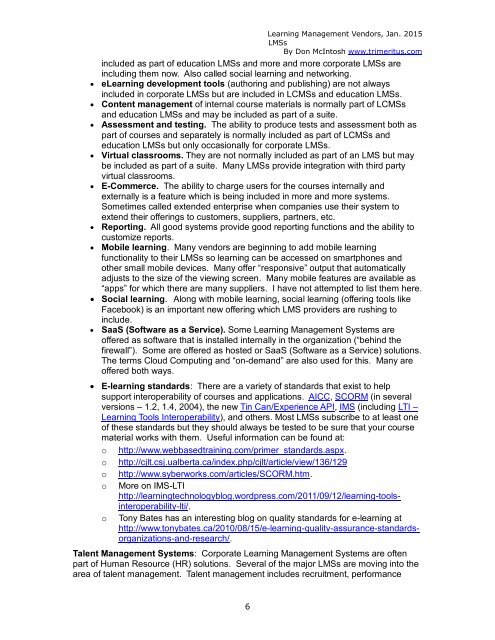HlCMz
HlCMz
HlCMz
- No tags were found...
Create successful ePaper yourself
Turn your PDF publications into a flip-book with our unique Google optimized e-Paper software.
Learning Management Vendors, Jan. 2015LMSsBy Don McIntosh www.trimeritus.comincluded as part of education LMSs and more and more corporate LMSs areincluding them now. Also called social learning and networking. eLearning development tools (authoring and publishing) are not alwaysincluded in corporate LMSs but are included in LCMSs and education LMSs. Content management of internal course materials is normally part of LCMSsand education LMSs and may be included as part of a suite. Assessment and testing. The ability to produce tests and assessment both aspart of courses and separately is normally included as part of LCMSs andeducation LMSs but only occasionally for corporate LMSs. Virtual classrooms. They are not normally included as part of an LMS but maybe included as part of a suite. Many LMSs provide integration with third partyvirtual classrooms. E-Commerce. The ability to charge users for the courses internally andexternally is a feature which is being included in more and more systems.Sometimes called extended enterprise when companies use their system toextend their offerings to customers, suppliers, partners, etc. Reporting. All good systems provide good reporting functions and the ability tocustomize reports. Mobile learning. Many vendors are beginning to add mobile learningfunctionality to their LMSs so learning can be accessed on smartphones andother small mobile devices. Many offer “responsive” output that automaticallyadjusts to the size of the viewing screen. Many mobile features are available as“apps” for which there are many suppliers. I have not attempted to list them here. Social learning. Along with mobile learning, social learning (offering tools likeFacebook) is an important new offering which LMS providers are rushing toinclude. SaaS (Software as a Service). Some Learning Management Systems areoffered as software that is installed internally in the organization (“behind thefirewall”). Some are offered as hosted or SaaS (Software as a Service) solutions.The terms Cloud Computing and “on-demand” are also used for this. Many areoffered both ways. E-learning standards: There are a variety of standards that exist to helpsupport interoperability of courses and applications. AICC, SCORM (in severalversions – 1.2, 1.4, 2004), the new Tin Can/Experience API, IMS (including LTI –Learning Tools Interoperability), and others. Most LMSs subscribe to at least oneof these standards but they should always be tested to be sure that your coursematerial works with them. Useful information can be found at:o http://www.webbasedtraining.com/primer_standards.aspx.o http://cjlt.csj.ualberta.ca/index.php/cjlt/article/view/136/129o http://www.syberworks.com/articles/SCORM.htm.o More on IMS-LTIhttp://learningtechnologyblog.wordpress.com/2011/09/12/learning-toolsinteroperability-lti/.o Tony Bates has an interesting blog on quality standards for e-learning athttp://www.tonybates.ca/2010/08/15/e-learning-quality-assurance-standardsorganizations-and-research/.Talent Management Systems: Corporate Learning Management Systems are oftenpart of Human Resource (HR) solutions. Several of the major LMSs are moving into thearea of talent management. Talent management includes recruitment, performance6


